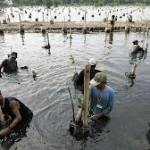Southeast Asia Fisheries Development Center Scientist Emerita and Zoological Society of London (ZSL) Chief Mangrove Scientific Advisor Dr. Jurgenne Primavera reported that the ‘region has the highest rate of mangrove loss.’
Data show Southeast Asia hosts about a third of global mangrove area totaling some 14 million to 15 million hectares at present.
Marcial Amaro Jr., director of the Ecosystems Research and Development Bureau (ERDB), raised urgency for such collective action, noting studies show aquaculture and other economic activities, population pressure and natural disasters amidst climate change are reducing Southeast Asia’s mangrove areas.
Such mangroves are the most diverse in terms of flora and fauna composition with 18 plant species being endemic to the region.
Experts noted mangroves are a group of salt-tolerant plants that occupy the inter-tidal zone of sheltered coasts around estuaries and lagoons.
Aside from serving as nesting and foraging ground for various species, they said mangrove areas are sources of wood and non-wood products.
They likewise noted that mangroves help absorb climate change-driving carbon emissions and buffer coastal communities against sea surges.
Southeast Asian nations are boosting efforts to save this region’s mangrove areas from further destruction and decline.
The plan includes establishing a common ASEAN database and mangrove information center as well as undertaking cooperation projects on mangrove research and development (R&D).
Dr. Honorato Palis from ERDB pointed out R&D funding constraints likewise affect efforts for saving Southeast Asia’s mangroves.
He noted funding allocation in Thailand and the Philippines for respective mangrove R&D activities are way below UNESCO’s recommendation of at least one percent of gross national product.
The countries’ allocation are only about 0.26 percent and 0.12 percent, respectively while developed countries’allocation is at two percent, he reported.
Panay and Guimaras islands are the ZSL’s community-based rehabilitation project in the Philippines and has yielded significant lessons for enhancing efforts to regenerate mangroves.
Among such lessons are shifting mangrove planting activities from seafront sites to abandoned ponds when possible.
Lessons learnt from the project will help improve mangrove reforestation in the Philippines where the standard practice is to plant bakhaw propagules in seafront sites that are selected during spring low tides, according to Primavera.
Authorities concerned earlier decided to hold the congress so that ASEAN experts can discuss the latest R&D information on mangrove resource management across Southeast Asia.
